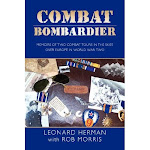
I had the pleasure of talking with 95th BG ball turret gunner Robert 'Bob' Fay this evening as part of the final research for my book. Fay flew 35 missions in a B-17 Flying Fortress between September 13, 1944 and early March, 1945. Throughout his time at Horham, Fay kept a diary. "I'd come home from a mission, and make notes while it was still fresh in my mind," he remembers. However, at the end of the war, before he could send the diary home, it had to be passed by the Army censors. "They gutted the center section out, and left the rest. Later, when I was back in the States, they shipped the gutted part to me after censoring."
Fay flew on the Hiram Griffin crew, in the 334th Squadron. He ended up in the ball turret because of his small stature. At first, we flew whatever plane was available. When they showed up at their barracks, they found they had been assigned to Barracks 13. There was only one man inside. He had missed the mission a few days previously, and the other men of the two crews who shared the barracks with him had been shot down. "He was the only one left in there," remembers Fay, "and he was really in trouble mentally by that time." The Griffin crew promptly changed the number of their barracks to 12-B.
Finally, after a few missions, "we got a new bird and we named it Victory Devil. On missions, lots of times things didn't work out. You'd be pushed to a secondary target due to weather mostly, and when that happened, you often got a lot more than you asked for." One particularly memorable mission was to Merseberg, to hit a synthetic oil plant on November 14, 1944. We had to bomb with PFF (Pathfinder radar) even though we could see fairly well. The Germans had put up a smoke-screen that obliterated the target. But we made a tragic error. We turned twenty miles too late, and went over the target through a flak area. We were suddenly in range of hundreds of guns, and had to put up with fifteen minutes of flak. Wicker's crew burst into flames and damn near took us down with him. Grif saved the day by cutting the throttle. We lost fifty-six bombers and 30 fighters that day, because of that error. I wrote at the time that considering the loss of life and equipment, the mission was a failure."
Fay did not particularly mind the tight confines of the ball turret. However, there were several things he didn't care for. First, "I didn't like the fact that the ball had a door that had to be opened for you to get out, and if it didn't rotate right, you were a cooked goose. You had no chute in the ball; there was no room. Second, it was damn cold down there."
"I had to get pulled out twice after losing my oxygen. Fortunately, our crew called around frequently and made sure everybody answered. It was a team effort. I was pulled out unconscious by our waist gunner, Bob Hamlin. I owe him a debt for that."
Close calls were frequent. Fay saw many bombers explode, or go down in flames, as well as American and German fighter aircraft. Flying in the winter of 1944 was dangerous, as the weather was terrible. On a December 16 mission to Stuttgart, the weather got so bad that Griffin had to drop out of formation and try to return alone. "We were out of oxygen, so had to drop to lower altitude. By the time we got back, you could hardly see the runway. Three ships overshot the runway that day and had to be scrapped."
Flak was the main enemy on many missions. "We'd get briefed for twelve flak guns and then we'd go over the target and there would be 100. On one mission down the Ruhr Valley, we ran the gauntlet of 1,200 flak guns. And then on another mission, there would be none."
German fighters still made frequent calls. Once, Fay saw two of the new German jet fighters, the Me262s, suddenly scream through the formation. "All they did was fly through and by the time I got a burst off they were gone! We knew they (Me262s) were there but didn't know when we'd run into them."
The closest Fay came to death was when a German shell ricocheted off the armor-plate behind his back in the ball, tearing a gash in the only place on the ball that could withstand such a hit. Otherwise, I would not be here."
As the crew neared the magic number 35, they had to try to make sure to finish at roughly the same time. Some days, one or more of the crew would be sick or couldn't fly. At the end of Fay's tour, he had to fly two missions after most of the rest were finished. "They all were there waiting for me at the end of the runway when I came back."
After the war, Fay didn't talk much about his experiences, but after a while, I began to get together with the other men on the crew. To this day, Fay and his wife have visits with the crew's original navigator, Bob Inman, as well as the co-pilot, Ken Wright. All three made it to the reunion in Dallas, Texas in October.
"We were very fortunate," he says.






2 comments:
Thanks for this, Rob....made some very interesting reading. 15 minutes of flak! Doesn't bear thinking about, does it?.............
You mentioned the B-17 "Victory Devils". I have a photo of that aircraft from my grandfather's collection posted on Flickr. http://www.flickr.com/photos/7247251@N07/3317709191/
He was a pilot with the 334th. I also recognize the name Griffin from a couple of mission flimsies he saved.
Thanks for your blog.
Post a Comment